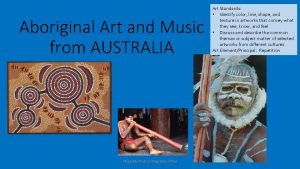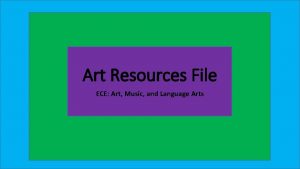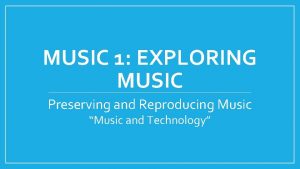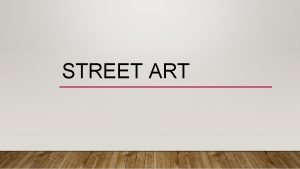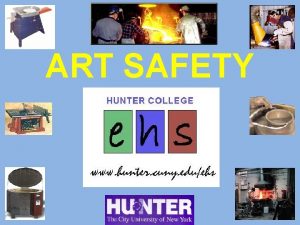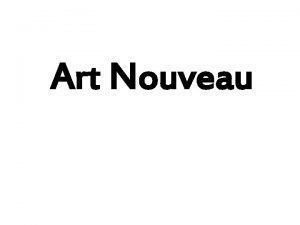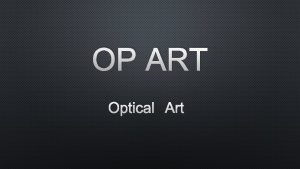K to 12 MUSIC The Music and Art














- Slides: 14

K to 12 MUSIC

The Music and Art curricula focus on the learner as the recipient of the knowledge, skills, and values necessary for artistic expression and cultural literacy. The design of the curricula is student-centered, based on spiral progression, and grounded in performance-based learning.

Thus, the learner is empowered, through active involvement and participation, to effectively correlate music and art to the development of his/her own cultural identity and expand his/her vision of the world.



Grade Level Standards Grade 1 The learner demonstrates basic understanding of the fundamental processes in music and art, through performing, creating, listening and observing, and responding.

K TO 12 MUSIC Music Elements �Rhythm �Melody �Form �Timbre �Dynamics �Tempo �Texture �Harmony * �*No formal instruction in harmony from K to 3 Music Processes - Listening - Reading - Imitating (re-creating) - Responding - Creating - Performing (including movement) - Evaluating - Analyzing critically - Applying (transference)

Content I. RHYTHM Content Standards Performance Standards Learning Competencies The learner…. * What is sound? Distinction between sound and silence * Steady beats (ostinato) * Simple rhythmic patterns *demonstrates basic * identifies the difference understanding of between sound and sound, silence and silence accurately. rhythm. *maintains a steady beat *develops musical when chanting, walking, awareness and tapping, clapping and creativity in playing musical expressing instruments. himself/herself while doing the *plays simple ostinato fundamental patterns on classroom processes in music. instruments and other sound sources. * associates icons with sound and silence within a rhythmic pattern. * performs claps, taps, chants, walks, and plays musical instruments in response to sound with the correct rhythm - In groupings of 2 s. - In groupings of 3 s. - In groupings of 4 s. * performs echo clapping. *creates simple ostinato patterns in groupings of 2 s, 3 s, and 4 s through body movements. Ex. Sticks, drums, triangle, nails, coconut shells, bamboo, empty boxes, etc.

II. MELODY * demonstrates understanding of pitch and simple melodic patterns. *matches the correct pitch of tones with other sound sources. * identifies the pitch of tone as - high. - low. * Pitch The learner…. The Learner. . . * matches the melody of a song with correct pitch vocally. * Simple machines patterns III. FORM * Musical lines * Beginnings and endings in Music shows recognition of pattern changes with body movement. * demonstrates understanding of the basic concepts of musical lines, beginnings and endings is music, and repeats in music. * shows recognition of pattern changes with body movement. * responds to high and low tones through body movements, singing, and playing other sources of sounds. * identifies musical lines as - Similar or - Dissimilar * associates geometric - through shapes to indicate movements and understanding of same geometric shapes different patterns. or objects.

IV. TIMBRE • Sound Quality *Distinction between singing and talking V. DYNAMICS * demonstrates understanding of the basic concepts of timbre. *uses voice and other sources of sound to produce a variety of timbres. * Responds to differences in sound quality with appropriate movement. • identifies the source of sounds - Wind, wave, * demonstrates understanding of the basic concepts of dynamics * uses dynamic levels to enhance poetry , chants, drama, and musical stories. *interprets through body movements the dynamics of a song. Ex. - Small movement – soft - Big movement – loud swaying of the trees, animal sounds, sounds produced by machines, transportation, through body movements.

Content Standards Performance Standards Learning Competencies *Sound volume The Learner…. * shows dynamic *associates dynamics with the movements of animals. *Distinction between loudness and softness in Music changes with movements. * uses terms “loud” and “soft” to identify volume changes. -Elephant walk – loud - Tiny steps of dwarf – soft

VI. TEMPO • Sound Speed * Distinction between fastness and slowness in Music * demonstrates understanding of the basic concepts of tempo. * uses varied tempo to enhance poetry , chants, drama, and musical stories. *correlates tempo changes with movements. *uses terms ―fast‖ and ―slow‖ to identify tempo changes. * demonstrates the concept of tempo through movement. *responds to varied tempo with movement or dance. - Slow movement with slow music - Fast movement with fast music *mimics animal movements. - Horse –fast - Carabao –slow

VII. TEXTURE * Sound Quality * Distinction between “thin” and “thick” in Music *demonstrates understanding of the basic concepts and texture. * distinguishes between single musical line and multiple musical lines which occur simultaneously. *show awareness of texture by using visual images. *demonstrates the concept of texture by singing twopart round. Examples: - Are you Sleeping - Row Your Boat

Thank You!!
 Music music music
Music music music On monday i (have) math and art
On monday i (have) math and art Australian aboriginal art and music
Australian aboriginal art and music Hình ảnh bộ gõ cơ thể búng tay
Hình ảnh bộ gõ cơ thể búng tay Lp html
Lp html Bổ thể
Bổ thể Tỉ lệ cơ thể trẻ em
Tỉ lệ cơ thể trẻ em Chó sói
Chó sói Thang điểm glasgow
Thang điểm glasgow Chúa yêu trần thế
Chúa yêu trần thế Các môn thể thao bắt đầu bằng từ đua
Các môn thể thao bắt đầu bằng từ đua Thế nào là hệ số cao nhất
Thế nào là hệ số cao nhất Các châu lục và đại dương trên thế giới
Các châu lục và đại dương trên thế giới Công thức tiính động năng
Công thức tiính động năng Trời xanh đây là của chúng ta thể thơ
Trời xanh đây là của chúng ta thể thơ


